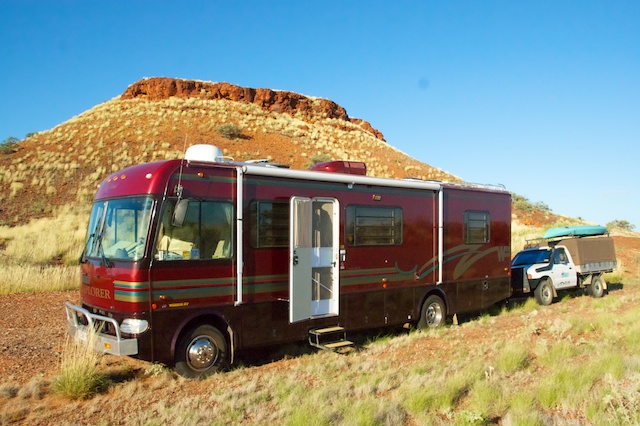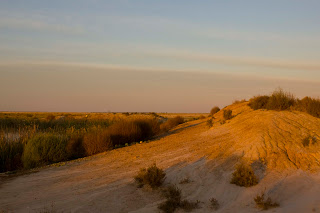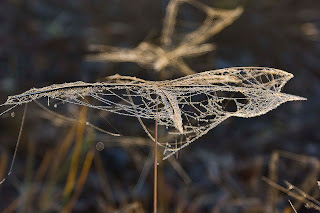Travelling along an isolated country New South Wales road, within the heart of Lachlan River country, just minding our own business - one of those brown touristy signs, pops up out of now where. Well, we weren't exactly no where - we were actually nearing a small town called Ootha - just between Forbes and Condobolin.
The Sign - well it reads "Utes In The Paddock' - well needless to say the temptation was all to much and even in Big Red, the stretch of dirt road did not daunt us. The road appears like any other, with sheep grazing with their young in the paddocks along side. Further down the road we see some 'anthill' like formations jutting out from behind a fence - getting closer we realise that we have found our "Utes In The Paddock". A truly unique and remarkable art installation - all a part of Burrawang West Station.
As an initiative to attract tourists to the small NSW town of Ootha, many residents donated the utes, and many a famous artist, their gift of artistry to instigate the project and now some years later there is now some 17 pieces of artwork - each with their own artistic interpretation - each as unique and individual as the next.
The Spirit of the Bush is Truly Alive!!
And this artwork is truly a dedication to those bush people...... The bush land surrounding the installation offers a blank canvas to each of the artists, and is one of Australia's truly unique art galleries.
Thousands of people visit the gallery every year to witness and promote the beauty and wonder of what is Lachlan River Country - that is the back drop for many of the very well known artists. Artists such as well known Silverton artist Peter Brown and John Murray from Lightening Ridge.
"Go Vegemite"
Ute: 1960 FB Artist: Rob Keen
Donated by the Kirk Family
"I said. 'Do you speak a my language?'. He just smiled and gave me a vegemite sandwich.
I Come from the land down under...."- Down Under - by Men at Work.
Vegemite take the cake for the growing Aussie Children who spread the smooth, salty, sticky food paste made from yeast extract, on just about anything edible. And next to an Australian passport, a stash of Vegemite is the easiest way of identifying an Aussie Traveller.
Originally introduced in 2 oz amber glass jars in 1923, a 115gm jar of Vegemite was the first produced into Australian supermarkets to be electronically scanned. By the late 1990's the country went through 22 million jars a year - making us a country of happy little vegemites"!
UteZilla
Artists: Jim Moginie & Stephen Coburn
Ute: 1957 FE Ute Donated by Barry Wright
Interfering with nature has its consequences. Once there was Frankenstein - then came "Godzilla". And now...meet UteZilla!
Super adapted, UteZilla deserves some respect. A wonder mother, she is almost always pregnant, has a joey in her pouch and a larger offspring at the heel and can produce two different kinds of milk simultaneously for the newborn and the older Joey.
If she is under prssure, she stops breeding altogether, creating her own 'dry period', during times of prolonged drought. And she even determines the gender of her offspring, waiting t bear males, until she is older.
If hurried, she tucks her joey safely away in her pouch and uses her phenomenal leaping power to rapidly travel long distances.
Left alone, she is a picture of contentment, but she is no 'Skippy'. Threaten her or her joey and she becomes ...the mother of all mothers. So run when she stands to fight or watch out. If her powerful punch doesn't get you, her killer kick will.
Drizakubra
Ute: 1981 WB Artist: Belinda Williams
Ute Donated by: Chris Muir and Matthew Collin
Typically clad in his Driza-Bone oilskin coat and Akubra hat,
a bushman symbolizes the spirit of the bush and the character of Australia's outback people. Hardworking, practical, down to earth, rugged and reliable.
TribUte
Ute: 1964 EH Artist: Lewis Burns
Ute Donated by: Hugh Hall and Coobang Pastoral Co.
"The traditional symbols used in Aboriginal art across the country, tell stories of the land and the tribes, depict our culture and our being". - Lewis Burns.
This is the story of the local Wiradjuri people. Dots represent life force, activity and movement. U shape is the ground imprint left by sitting cross legged.
Tools distinguish women from men around the campfire; Coolamon (bark or wooden dish) and gunny (digging stick) indicate women who gather bush tucker, and spears and boomerangs identify men.
The Southern Cross and dreamtime corroboree depict the creation dance in the sky. Hands represent ancestors' spirits, with a single hand holding a painting to explain how aboriginal culture is passed on through art, stories, song and dance. A road or modern path behind rivers and water holes to show that nature is still more important to Aboriginal Culture and survival than manmade inventions.
Dame Edna's Looute
Ute: 1965 HD Artist: Karen Tooth
Ute Donated by: Taylors Auto
An Icon...On an icon...In an icon
Instantly recognised as one of Australia's great personalities, Dame Edna transformed herself from housewife to megastar. A transformation unparrelled in our country's. Growth from an isolated wild coolony to an innovtive player on the world stage.
On an icon...once there was a toilet outback in every yard of every house in Australia. Commonly referred to as the 'dunny', it is a true social and economic leveler. No matter who we are, we all have to make the trip 'outback'. In an icon...the holden utes - development reflects the changing social history of this country from a practical workhorse in earlier times, to a performance focused sports vehicle for today's work hard, play hard generation. What a surprise for all, for us to innocently discover Dame Edna on her Throne, reading her local newspaper.
Circle Work
Ute: 1972 HQ Artist: John Murray
Ute Donated by: Mike Taylor
True to the native bird's typically silly behaviour, these young galah's are enjoying the great Australian Tradition of doing circle work (doing donuts).
The sculptured galah on top represents the fun police towing away the ute.
Epitaph to Fossil Fuels
Ute: 1977 HZ Artist: Shane Gehlert
Ute donated by: Taylors Auto Centre Bowsers Donated: Danny Mooney
The all seeing eye watches as we struggle to break our dependance on dwindling fossil fuel resources. This satirical presentation comments on the the destructive impact of various powerful influences within modern culture on the well being of humans and our environment. Signature characters include "Roboroo" "St Bilby", (patron saint of global warming) and "Sam the Oil Man", with Chinese symbols of oil and water.
Emute
Ute: 1975 HJ Artist: Peter Browne
Ute donated by Burrawang West St.
Like kangaroos and echidnas, the presence of emus is a sure sign your in the bush. Comical looking creatures, their balding heads with oversized eyes, top necks that seem to stretch too far above bulbous bodies. They strut like courtesans at walking pace, but as lyricist John Williamson say of the emu, "He can't fly, but I'm telling you, he can run the pants off a kangaroo".
The Stockman
Ute: 1958 FC Artist: Michael Jones
Ute donated by: Russell and Tanya Jones
Often romanticized in classic literature, our outback hero's, come to life in this tribute to the stockman. Droving the "long paddock" means sleeping rough and making the most of limited resources along the way. Essential to survival in the outback is the intimate knowledge of the land shared by Aboriginal stockman.
Clancy Stops The Overflow
Ute: 1991 VS Artist: Peter Mortimore
Ute Donated by: Parkes Auto Wreckers
Our most celebrated stockman comes to the rescue again, this time preventing a disastrous waste of valuable "Bundy". With the help of his loyal steed, "Banjo", Clancy arrives just in the nick of time to the save the spillage of liquid gold that ensures any party is fair dinkum Aussie.
Central West Medley
Ute: 1961 EK Artist: Keith Willis
This comical recollection of the life and times of our early settlers, illustrates the indelible heritage of their character on outback society.
Against the backdrop of a rugged yet colorful landscape, human eccentricity prevails as the heart of classic Aussie humour.
Clean Running
Ute: 1954 FJ Artist: Paul Blahuta
Ute Donated by Burrawang West Station and Taylor's Auto
Famous outlaw Ned Kelly stays true to form as he pulls off another hold up.
This time the victim is the artist, who felt compelled to use Ned's form and story as an integral part of outback history. The horses transparency represents the fact that the horses are not native to Australia, so not a solid part of its landscape. In this scene, they provide and alternate source of energy...true clean horse power.
Golden Valley
Ute: 1970 HG Artist: Greg Breman
Donated by: George Brown
From colonial times, rural enterprise has played a pivotal role in our country's economic health. innovative pursuit of all facets of rural industry continues to contribute significantly to the flow of wealth in outback Australia, as depicted in the traditional montage of sheep shearing, livestock grazing, irrigation and cropping.
Ute Of Arms
Ute: 1952 FX Artists: Brad Brown and Scott Edwards
Donated by: Taylors Auto Centre
Where, there's a will, there's a way. Like the ever present ants of the outback, Aussie's get through it, go around it, dig under it or just get over it. The red kangaroo and emu, which can't move backward, were chosen as the symbols of progressive, pioneering spirit of Australian people in the Country's Coat of Arms.
What more fitting place could there be for the first model Holden ute than at the heart of this outback interpretation of the same theme? No matter which way the wind blows, the ute is always facing forward.
Wiradjuri 'Uth' Story
Ute: 1993 VS Artists: Young People of Condobolin Youth Services
Donated by: NRMA Insurance
Painted as seen from above, this artwork depicts travelling, throughout the Wiradjuri area, of landscape of rivers, land and animals.
As in the Aboriginal flag, colors in the painting have specific meaning, red represents the earth, black symbolises people and yellow suggests the sun. Rivers running through the are bring life to the land and denoted by the color white. U shapes show where people gather around white circle waterholes and black circle campfires. Gathering in such a manner is strong tradition for the Wiradjuri people. The flow of the Lachlan River and adjoining creeks is represented by curving white line. In keeping with tradition, the young artists signed their work with their hand prints.
Supplementary Feeder
When the feed is scarce and the livestock are hungry, a bale in the ute is a life or death story; The humming and squeaking as it crosses hard ground, brings cttle running from a long way around. Cause a ute in the paddock is a promising sound.
Dents and dings across this utes boy testify to the fact that livestock, focused on food, show little respect for the feeder from which the food falls. Like wrinkles of age, its body worn by tough times on the land. Life outback is full of challenge. Good times and bad, it leaves its mark on the body and soul. Here, a love of living on the land "beyond the sandstone' curtain" is painted into life. Landscapes of vivid colors. Charismatic characters. A weathered Yarrabandai woolshed. And the farmer's best friend...a paddock bashing ute.
Simple Pleasures
Ute: 1968 HK Artist: Leo Robba
Donated by: Time and Sue Jones
There's simple pleasure in the natural beauty of the Lachlan River Valley. Vast stretches of waving grass in shades of green and tawny gold. Elegant stands of swaying eucalpt. Glistening waterways. A broad glistening canopy of night sky. Early settlers might have seen a different picture when tehy arrived in the bush, way out west from the relatively safe coastal coolony. Whatever their hardships and discomforts were, these peioneering, enterprising immigrants left enduring evidence of their success. Success with the land i shown by fields of grazing grass for sheep that supplied the wood industry on which the nation was built.
Success with harsh condition is demonstrated in every classic Australian homestead with wide covered verandahs. to protect against a blazing sun, numerous doorways and windows to catch the breeze, and high ceilings to pull warm summer air away from the ground. And success with their commitment to create a better life for themselves is captured in its purest demonstration of comfort and pride by a garden of simple pleasures.
The descriptions and interpretations of the artwork is as supplied by the plaques installed along with the artwork. This installation is just an outstanding credit to those that created it and a tribute to the people of the outback.
If given the opportunity it is well worth the visit.






























































